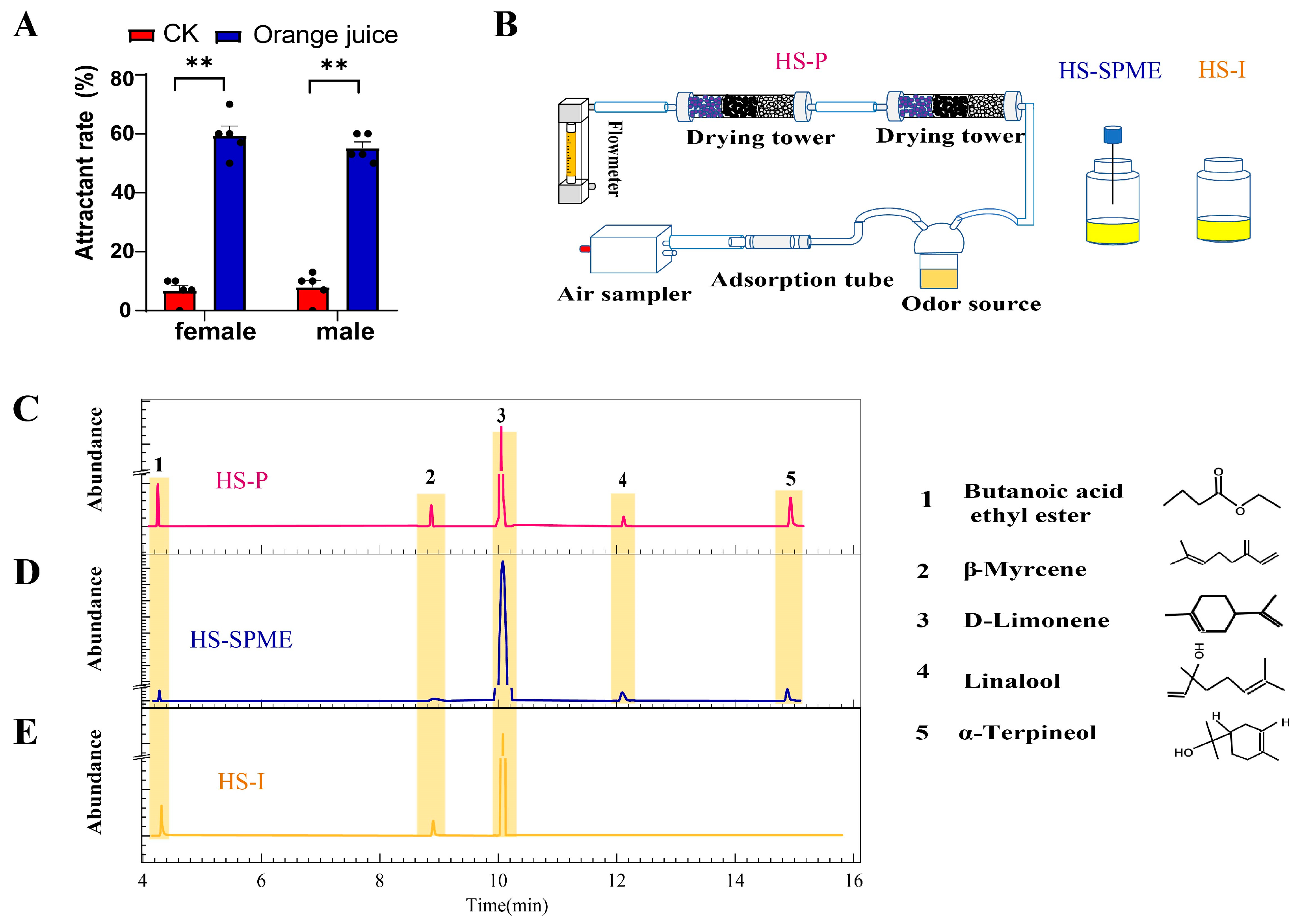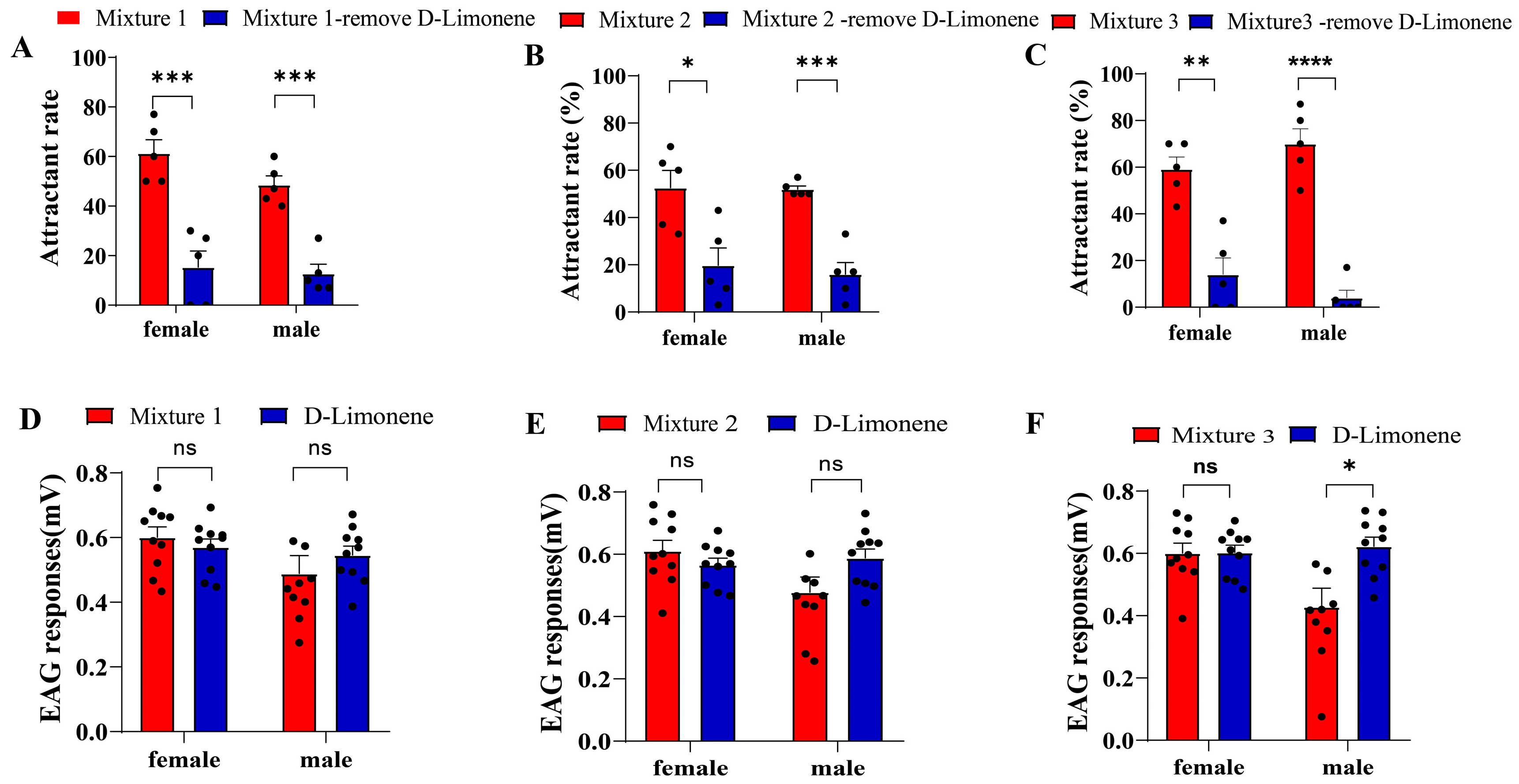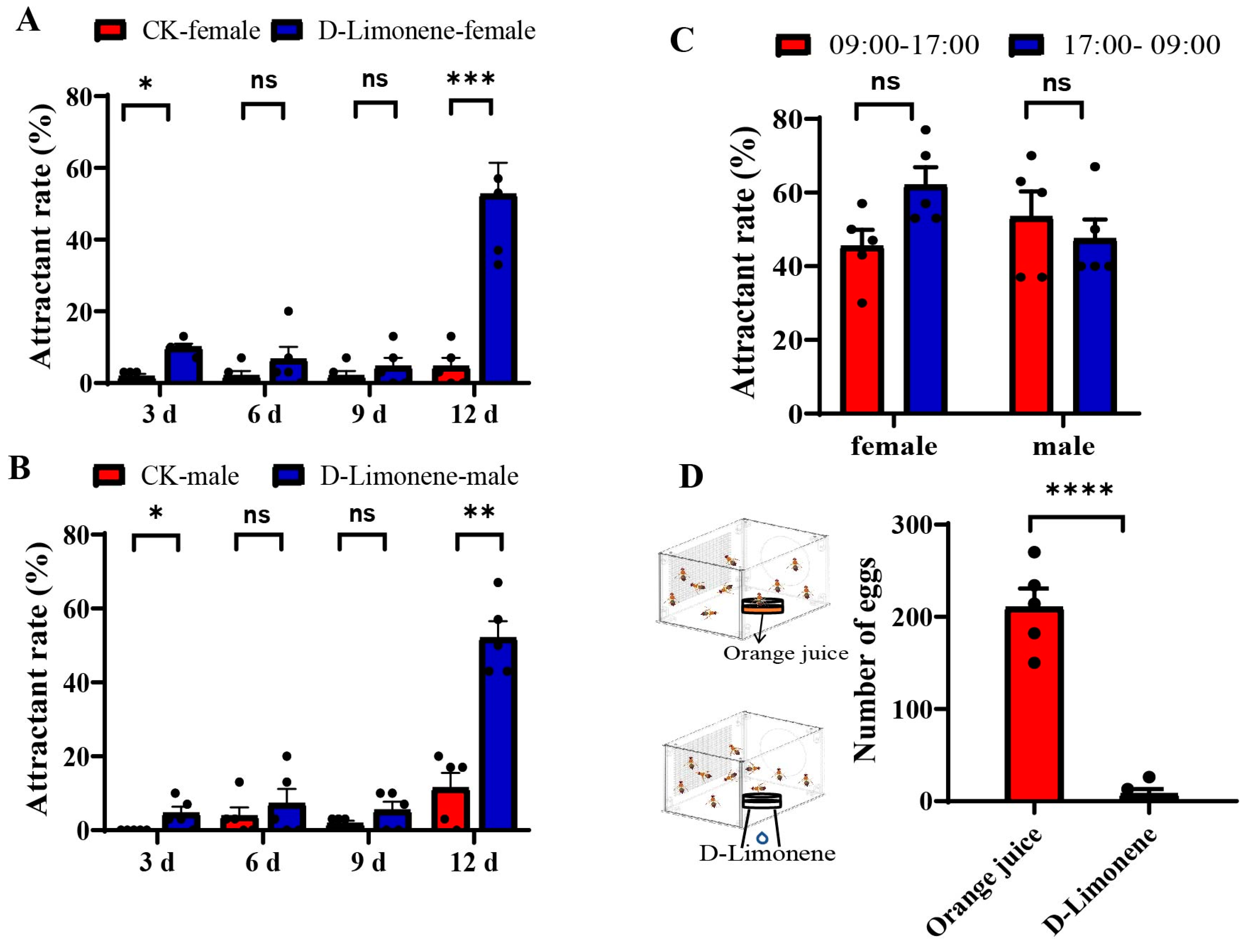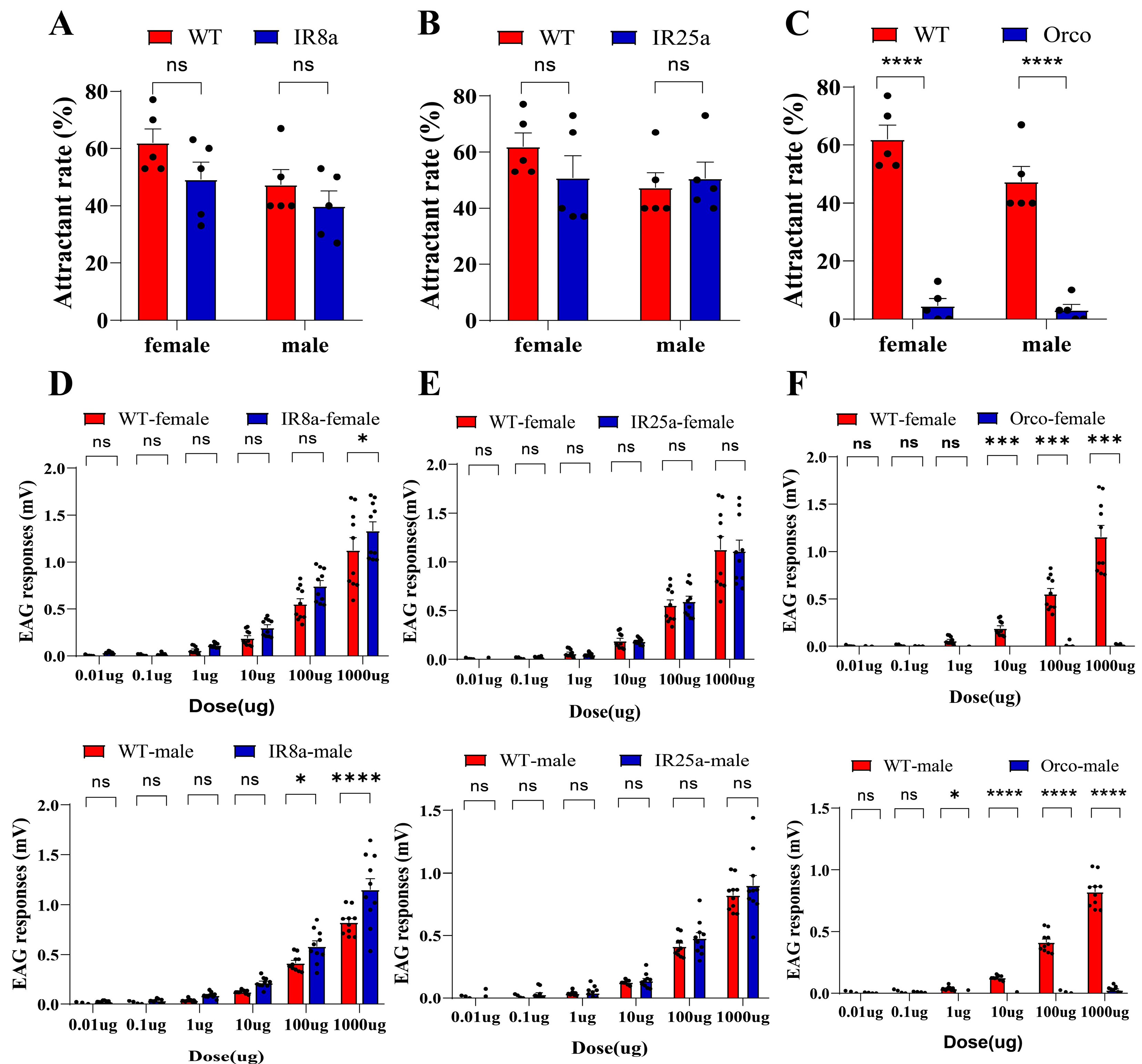D-Limonene Is the Active Olfactory Attractant in Orange Juice for Bactrocera dorsalis (Insecta: Diptera: Tephritidae)
Abstract
1. Introduction
2. Materials and Methods
2.1. Insect Rearing
2.2. Identification of Volatile Compounds by GC-MS
2.3. Preparation of Commercial Lure and Synthetic Chemicals
2.4. Olfactory Trap Assay
2.5. Electroantennography Recording
2.6. Statistical Analyses
3. Results
3.1. Identification of the Main Volatile Components from Orange Juice
3.2. Identification of the Behavior-Modifying Components in the Main Volatiles from Orange Juice That Attract B. dorsalis Adults
3.3. The Attractiveness of D-Limonene to Adult B. dorsalis of Different Ages and Time Periods and Its Impact on Oviposition Behavior
3.4. The Candidate Olfactory Receptors Mediate the Perception and Behavioral Response of B. dorsalis Adults to D-Limonene
4. Discussion
5. Conclusions
Author Contributions
Funding
Institutional Review Board Statement
Informed Consent Statement
Data Availability Statement
Conflicts of Interest
Correction Statement
Appendix A

Appendix B
| Component Name | Retention Time | CAS | Peak Area | Area Percentage |
|---|---|---|---|---|
| D-Limonene | 10.092 | 5989-27-5 | 385536463 | 86.6% |
| butanoic acid ethyl ester | 4.565 | 105-54-4 | 21978813 | 4.9% |
| α-terpineol | 14.917 | 98-55-5 | 15964525 | 3.6% |
| linalool | 12.127 | 78-70-6 | 6804550 | 1.5% |
| β-myrcene | 8.935 | 123-35-3 | 6236712 | 1.4% |
| α-Pinene | 7.452 | 80-56-8 | 3872509 | 0.9% |
| 3-Carene | 9.478 | 13466-78-9 | 1713825 | 0.4% |
| Terpinen-4-ol | 14.502 | 562-74-3 | 1707471 | 0.4% |
| Cyclohexene, 1-methyl-4-(1-methylethylidene)- | 11.725 | 586-62-9 | 1387022 | 0.3% |
Appendix C
| Component Name | Retention Time | CAS | Area | Area Percentage |
|---|---|---|---|---|
| D-Limonene | 10.092 | 5989-27-5 | 765684109 | 89.1% |
| linalool | 12.127 | 78-70-6 | 16984675 | 2.0% |
| α-terpineol | 14.917 | 98-55-5 | 16539699 | 1.9% |
| butanoic acid ethyl ester | 4.565 | 105-54-4 | 15099217 | 1.8% |
| β-myrcene | 8.935 | 123-35-3 | 11431360 | 1.3% |
| (-)-Carvone | 16.309 | 6485-40-1 | 8960808 | 1.0% |
| α-Pinene | 7.452 | 80-56-8 | 7367255 | 0.9% |
| Terpinen-4-ol | 14.502 | 562-74-3 | 7233630 | 0.8% |
| γ-Terpinene | 10.913 | 99-85-4 | 5046379 | 0.6% |
| 3-Carene | 9.478 | 99-85-4 | 4047025 | 0.5% |
| Cyclohexene, 1-methyl-4-(1-methylethylidene)- | 11.725 | 586-62-9 | 861886 | 0.1% |
Appendix D
| Component Name | Retention Time | CAS | Area | Area Percentage |
|---|---|---|---|---|
| D-Limonene | 10.082 | 5989-27-5 | 408215296 | 92.5% |
| butanoic acid ethyl ester | 4.318 | 105-54-4 | 15358132 | 3.5% |
| β-myrcene | 8.902 | 123-35-3 | 11328418 | 2.6% |
| α-Pinene | 7.366 | 80-56-8 | 2963893 | 0.7% |
| γ-Terpinene | 10.917 | 99-85-4 | 1780294 | 0.4% |
| β-Ocimene | 9.462 | 13877-91-3 | 949729 | 0.2% |
| Cyclohexene, 1-methyl-4-(1-methylethylidene)- | 11.716 | 586-62-9 | 528556 | 0.1% |
References
- Shelly, T.; Epsky, N.; Jang, E.B.; Reyes-Flores, J.; Vargas, R. Trapping and the Detection, Control, and Regulation of Tephritid Fruit Flies; Springer: Dordrecht, The Netherlands, 2014. [Google Scholar]
- Duyck, P.F.; David, P.; Quilici, S. A review of relationships between interspecific competition and invasions in fruit flies (Diptera: Tephritidae). Ecol. Entomol. 2004, 29, 511–520. [Google Scholar] [CrossRef]
- Christenson, L.D.; Foote, R.H. Biology of fruit flies. Annu. Rev. Entomol. 1960, 5, 171–192. [Google Scholar] [CrossRef]
- Clarke, A.R.; Armstrong, K.F.; Carmichael, A.E.; Milne, J.R.; Raghu, S.; Roderick, G.K.; Yeates, D.K. Invasive phytophagous pests arising through a recent tropical evolutionary radiation: The Bactrocera dorsalis complex of fruit flies. Annu. Rev. Entomol. 2005, 50, 293–319. [Google Scholar] [CrossRef] [PubMed]
- Hsu, J.C.; Feng, H.T. Insecticide susceptibility of the oriental fruit fly Bactrocera dorsalis (Hendel) (Diptera:Tephritidae) in Taiwan. Chin. J. Entomol. 2000, 20, 109–118. [Google Scholar]
- Wang, Y.L. Study advance in incidence and trap control of Bactrocera dorsalis (Hendel). J. Environ. Entomol. 2013, 35, 253–259. [Google Scholar]
- Chen, L.J.; Meng, Q.Q.; Li, Z.Q.; Zhang, S.Q.; Zeng, L.; Lu, Y.Y. The resistance monitoring of Bactrocera dorsali in the field of Shenzhen. Chin. Plant. Protect. 2015, 35, 63–66. [Google Scholar]
- Hokkanen, H.M.T. Trap cropping in pest management. Annu. Rev. Entomol. 1991, 36, 119–138. [Google Scholar] [CrossRef]
- Gregg, P.C.; Socorro, A.P.D.; Hawes, A.J.; Binns, M.R. Developing bisexual attract-and-kill for polyphagous insects: Ecological rationale versus pragmatics. J. Chem. Ecol. 2016, 42, 666–675. [Google Scholar] [CrossRef]
- Allwood, A.; Vueti, E.T.; Leblanc, L.; Bull, R. Eradication of Introduced Bactrocera Species (Diptera: Tephritidae) in Nauru Using Male Annihilation and Protein Bait Application Techniques. In Turning the Tide: The Eradication of Invasive Species; IUCN SSC Invasive Species Specialist Group: Gland, Switzerland, 2002; pp. 19–25. [Google Scholar]
- Vincenzi, M.D.; Silano, M.; Stacchini, P.; Scazzocchio, B. Constituents of aromatic plants: I. Methyleugenol. Fitoterapia 2000, 71, 216–221. [Google Scholar] [CrossRef]
- Zhou, G.D.; Moorthy, B.; Bi, J.; Donnelly, K.C.; Randerath, K. DNA adducts from alkoxyallybenzene herb and spice constituents in cultured human (HepG2) cells. Environ. Mol. Mutagen. 2007, 48, 715–721. [Google Scholar] [CrossRef]
- Uchida, G.K.; Mackey, B.E.; Vargas, R.I.; Beardsley, J.W.; Hardy, D.E.; Goff, M.L.; Stark, J.D. Response of non-target insects to methyl eugenol, cue-lure, trimedlure, and protein bait on Kauai Island, Hawaiian Islands. Proc. Hawaii. Entomol. 2006, 38, 41–71. [Google Scholar]
- Siderhurst, M.S.; Jang, E.B. Cucumber Volatile Blend Attractive to Female Melon Fly, Bactrocera cucurbitae (Coquillett). J. Chem. Ecol. 2010, 36, 699–708. [Google Scholar] [CrossRef] [PubMed]
- Zhang, A.; Linn, C.; Wright, S.; Prokopy, R.; Reissig, W.; Roelofs, W. Identification of a new blend of apple volatiles attractive to the apple maggot, Rhagoletis pomonella. J. Chem. Ecol. 1999, 25, 1221–1232. [Google Scholar] [CrossRef]
- Reissig, W.H. Field tests of traps and lures for the apple maggot. J. Econ. Entomol. 1974, 67, 484–486. [Google Scholar] [CrossRef]
- Pelz-Stelinski, K.S.; Gut, L.J.; Stelinski, L.L.; Liburd, O.E.; Isaacs, R. Captures of Rhagoletis mendax and R. cingulata (Diptera: Tephritidae) on sticky traps are influenced by adjacent host fruit and fruit juice concentrates. Environ. Entomol. 2005, 34, 1013–1018. [Google Scholar] [CrossRef]
- Prokopy, R.J.; Jácome, I.; Bigurra, E. An index for assigning distances between odor-baited spheres on perimeter trees of orchards for control of apple maggot flies. Entomol. Exp. Appl. 2005, 115, 371–377. [Google Scholar] [CrossRef]
- Ren, L.L.; Qi, L.Y.; Jiang, Q.G.; Zhou, S.D.; Dai, H.G. Oviposition preference of oriental fruit fly, Bactrocera dorsalis. Chin. Bull. Entomol. 2008, 45, 593–597. [Google Scholar]
- Vargas, R.I.; Chang, H.B. Evaluation of Oviposition Stimulants for Mass Production of Melon Fly, Oriental Fruit Fly, and Mediterranean Fruit Fly (Diptera: Tephritidae). J. Econ. Entomol. 1991, 84, 1695–1698. [Google Scholar] [CrossRef]
- Yuan, J.X.; Zhang, J.; Zhang, Y.; QiQiGe, W.Y.; Liu, W.; Yan, S.C.; Wang, G.R. Protocols for CRISPR/Cas9 Mutagenesis of the Oriental Fruit Fly Bactrocera dorsalis. J. Vis. Exp. 2022, 187, e64195. [Google Scholar]
- Zhang, J.; Liu, W.; Chang, H.T.; Wang, Q.; Yuan, J.X.; Liu, L.Y.; Liu, C.H.; Zhang, Y.; Ru, C.J.; Yan, S.C.; et al. Agricultural Genomics Institute at Shenzhen, Chinese Academy of Agricultural Sciences, Shenzhen, China. 2024, under review.
- Xu, J.; Liu, W.; Yang, D.H.; Chen, S.Q.; Chen, K.; Liu, Z.L.; Yang, X.; Meng, J.; Zhu, G.H.; Dong, S.L.; et al. Regulation of olfactory-based sex behaviors in the silkworm by genes in the sex-determination cascade. PLoS Genet. 2020, 16, e1008622. [Google Scholar] [CrossRef]
- Gregg, P.C.; Socorro, A.P.D.; Landolt, P.J. Advances in attract-and-kill for agricultural pests: Beyond pheromones. Annu. Rev. Entomol. 2018, 63, 453–470. [Google Scholar] [CrossRef] [PubMed]
- Shrivastava, G.; Rogers, M.; Wszelaki, A.; Panthee, D.R.; Chen, F. Plant volatiles-based insect pest management in organic farming. Crit. Rev. Plant Sci. 2010, 29, 123–133. [Google Scholar] [CrossRef]
- Pickett, J.A.; Khan, Z.R. Plant volatile-mediated signalling and its application in agriculture: Successes and challenges. New Phytol. 2016, 212, 856–870. [Google Scholar] [CrossRef] [PubMed]
- Murlis, J.; Elkinton, J.S.; Cardé, R.T. Odor plumes and how insects use them. Annu. Rev. Entomol. 1992, 37, 505–532. [Google Scholar] [CrossRef]
- Bruce, T.J.A.; Wadhams, L.J.; Woodcock, C.M. Insect host location: A volatile situation. Trends Plant Sci. 2005, 10, 269–274. [Google Scholar] [CrossRef] [PubMed]
- Bruce, T.J.A.; Pickett, J.A. Perception of plant volatile blends by herbivorous insects-finding the right mix. Phytochemistry 2011, 72, 1605–1611. [Google Scholar] [CrossRef] [PubMed]
- Tasin, M.; Bäckman, A.C.; Coracini, M.; Casado, D.; Ioriatti, C.; Witzgall, P. Synergism and redundancy in a plant volatile blend attracting grapevine moth females. Phytochemistry 2007, 68, 203–209. [Google Scholar] [CrossRef]
- Erasto, P.; Viljoen, A.M. Limonene-a review: Biosynthetic, ecological and pharmacological relevance. Nat. Prod. Commun. 2008, 3, 1193–1202. [Google Scholar] [CrossRef]
- Verghese, J. The chemistry of limonene and of its derivatives—Part I. Perfum. Essent. Oil. Rec. 1968, 59, 439–454. [Google Scholar]
- Massaldi, H.A.; King, C.J. Determination of volatiles by vapor headspace analysis in a multiphase system: D-Limonene in orange juice. J. Food Sci. 1974, 39, 434–437. [Google Scholar] [CrossRef]
- Marsili, R. Measuring volatiles and limonene-oxidation products in orange juice by capillary GC. LC-G 1986, 4, 358–362. [Google Scholar]
- Wen, T.; Sang, M.X.; Wang, M.L.; Han, L.B.; Gong, L.; Tang, X.H.; Long, X.Z.; Xiong, X.; Peng, H.L. Rapid detection of D-Limonene emanating from citrus infestation by Bactrocera dorsalis (hendel) using a developed gas-sensing system based on qcm sensors coated with ethyl cellulose. Sens. Actuat. B-Chem. 2021, 328, 129048. [Google Scholar] [CrossRef]
- Aazza, S.; Lyoussi, B.; Miguel, M.G. Antioxidant and antiacetylcholinesterase activities of some commercial essential oils and their major compounds. Molecules 2011, 16, 7672–7690. [Google Scholar] [CrossRef] [PubMed]
- Sun, J. D-Limonene: Safety and clinical applications. Altern. Med. Rev. 2007, 12, 259–264. [Google Scholar] [PubMed]
- Tripath, A.K.; Veena, P.; Khanuja, S.P.S.; Sushil, K. Effect of D-Limonene on three stored-product beetles. J. Econ. Entomol. 2003, 96, 990–995. [Google Scholar] [CrossRef]
- Sharaby, A.; Abdel-Rahman, H.; Moawad, S. Biological effects of some natural and chemical compounds on the potato tuber moth, Phthorimaea operculella zell. (lepidoptera:gelechiidae). Saudi J. Biol. Sci. 2009, 16, 1–9. [Google Scholar] [CrossRef] [PubMed]
- Shi, W.; Liu, H.; Ye, H. Behavioral response of Bactrocera dorsalis to five kinds of odor volatile of mango. Chin. Bull. Entomol. 2010, 47, 318–321. [Google Scholar]
- Jin, J.; Ruan, Z.Y.; Huang, Z.F.; Lai, G.Y.; Huang, S.S.; Fan, X.L. Attractions of volatiles from wax-apple fruit to the oriental fruit fly. J. South China Agric. Univ. 2015, 36, 71–77. [Google Scholar]
- Ugwu, J.A.; Ogunfumilayo, A.O. Comparative Efficacy of Two Fruit Juice Products as Attractants for Trapping Oriental Fruit Fly, Bactrocera dorsalis (Diptera: Tephritidae); CMV Verlag: Hamburg, Germany, 2020; pp. 156–163. [Google Scholar]
- Mo, R.J.; Ouyang, Q.; Zhong, B.E.; Wu, W.J. Attractiveness of durian fruit volatiles to Bactrocera dorsalis (Hendel). Chin. J. Appl. Entomol. 2014, 51, 1336–1342. [Google Scholar]
- Zhang, S.Y.; Xiao, C.; Ye, M.; Kang, M.; Wu, S.R.; Hu, C.H. Attraction of the volatiles from ripen banana pulp for Dacus dorsalis (Hendel). J. Huazhong. Agric. Univ. 2006, 25, 512–514. [Google Scholar]
- Flath, R.A.; Light, D.M.; Jang, E.B.; Mon, T.R.; John, J.O. Headspace examination of volatile emissions from ripening papaya (Carica papaya L. solo variety). J. Agric. Food. Chem. 1990, 38, 1060–1063. [Google Scholar] [CrossRef]
- Matthew, S.; Eric, J. Female-biased attraction of Oriental fruit fly, Bactrocera dorsalis (Hendel), to a blend of host fruit volatiles from Terminalia catappa. J. Chem. Ecol. 2006, 32, 2513–2524. [Google Scholar]
- Du, L.X.; Liu, Y.; Wang, G.R. Molecular mechanisms of signal transduction in the peripheral olfactory system of insects. Sci. Sin. Vitae 2016, 46, 573–583. [Google Scholar] [CrossRef]
- Fleischer, J.; Pregitzer, P.; Breer, H.; Krieger, J. Access to the odor world: Olfactory receptors and their role for signal transduction in insects. Cell. Mol. Life Sci. 2018, 75, 485–508. [Google Scholar] [CrossRef] [PubMed]
- Dobritsa, A.A.; Naters, W.V.D.G.V.; Warr, C.G.; Steinbrecht, R.A.; Carlson, J.R. Integrating the molecular and cellular basis of odor coding in the Drosophila antenna. Neuron 2003, 37, 827–841. [Google Scholar] [CrossRef]
- Root, C.M.; Ko, K.I.; Jafari, A.; Wang, J.W. Presynaptic facilitation by neuropeptide signaling mediates odor-driven food search. Cell 2011, 145, 133–144. [Google Scholar] [CrossRef]




| Compound Name | CAS | Brand Name | State |
|---|---|---|---|
| butanoic acid ethyl ester | 105-54-4 | Macklin | liquid |
| D-Limonene | 5989-27-5 | Macklin | liquid |
| linalool | 78-70-6 | Sigma-Aldrich | liquid |
| α-terpineol | 98-55-5 | Sigma-AldrichMAC | crystal |
| β-myrcene | 123-35-3 | aladdin | liquid |
| n-hexane | 110-54-3 | Sigma-Aldrich | liquid |
| paraffin oil | 8012-95-1 | Sigma-Aldrich | liquid |
| α-Pinene | 80-56-8 | Macklin | liquid |
| 3-Carene | 13466-78-9 | Macklin | liquid |
| Terpinen-4-ol | 562-74-3 | Macklin | liquid |
| (-)-Carvone | 6485-40-1 | Macklin | liquid |
| γ-Terpinene | 99-85-4 | Macklin | liquid |
| β-Ocimene | 13877-91-3 | Macklin | liquid |
| Cyclohexene, 1-methyl-4-(1-methylethylidene)- | 586-62-9 | Macklin | liquid |
| Name | D-Limonene | Butanoic Acid Ethyl Ester | α-Terpineol | Linalool | β-Myrcene |
|---|---|---|---|---|---|
| Mixture 1 | 82 (752.3 µg) | 12 (110.1 µg) | 8 (73.4 µg) | 4 (36.7 µg) | 3 (27.5 µg) |
| Mixture 1 without D-Limonene | 0 | 12 (110.1 µg) | 8 (73.4 µg) | 4 (36.7 µg) | 3 (27.5 µg) |
| Mixture 2 | 53 (791.0 µg) | 6 (89.6 µg) | 3 (44.8 µg) | 4 (59.7 µg) | 1 (14.9 µg) |
| Mixture 2 without D-Limonene | 0 | 6 (89.6 µg) | 3 (44.8 µg) | 4 (59.7 µg) | 1 (14.9 µg) |
| Mixture 3 | 58 (950.8 µg) | 2 (32.8 µg) | 0 | 0 | 1 (16.4 µg) |
| Mixture 3 without D-Limonene | 0 | 2 (32.8 µg) | 0 | 0 | 1 (16.4 µg) |
Disclaimer/Publisher’s Note: The statements, opinions and data contained in all publications are solely those of the individual author(s) and contributor(s) and not of MDPI and/or the editor(s). MDPI and/or the editor(s) disclaim responsibility for any injury to people or property resulting from any ideas, methods, instructions or products referred to in the content. |
© 2024 by the authors. Licensee MDPI, Basel, Switzerland. This article is an open access article distributed under the terms and conditions of the Creative Commons Attribution (CC BY) license (https://creativecommons.org/licenses/by/4.0/).
Share and Cite
Liu, L.; Yang, L.; Yuan, J.; Zhang, J.; Liu, C.; Zhou, H.; Liu, W.; Wang, G. D-Limonene Is the Active Olfactory Attractant in Orange Juice for Bactrocera dorsalis (Insecta: Diptera: Tephritidae). Life 2024, 14, 713. https://doi.org/10.3390/life14060713
Liu L, Yang L, Yuan J, Zhang J, Liu C, Zhou H, Liu W, Wang G. D-Limonene Is the Active Olfactory Attractant in Orange Juice for Bactrocera dorsalis (Insecta: Diptera: Tephritidae). Life. 2024; 14(6):713. https://doi.org/10.3390/life14060713
Chicago/Turabian StyleLiu, Leyuan, Lang Yang, Jinxi Yuan, Jie Zhang, Chenhao Liu, Hongxu Zhou, Wei Liu, and Guirong Wang. 2024. "D-Limonene Is the Active Olfactory Attractant in Orange Juice for Bactrocera dorsalis (Insecta: Diptera: Tephritidae)" Life 14, no. 6: 713. https://doi.org/10.3390/life14060713
APA StyleLiu, L., Yang, L., Yuan, J., Zhang, J., Liu, C., Zhou, H., Liu, W., & Wang, G. (2024). D-Limonene Is the Active Olfactory Attractant in Orange Juice for Bactrocera dorsalis (Insecta: Diptera: Tephritidae). Life, 14(6), 713. https://doi.org/10.3390/life14060713





